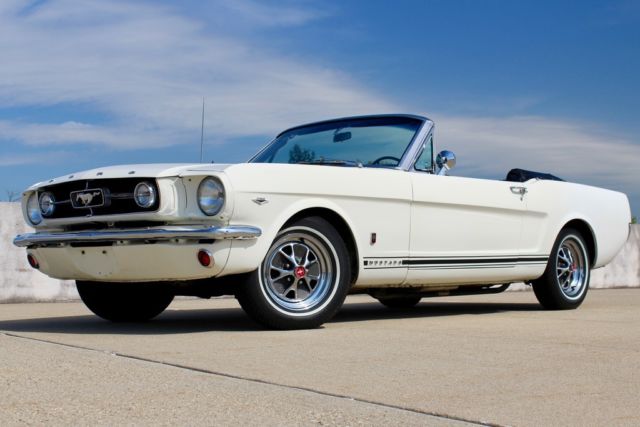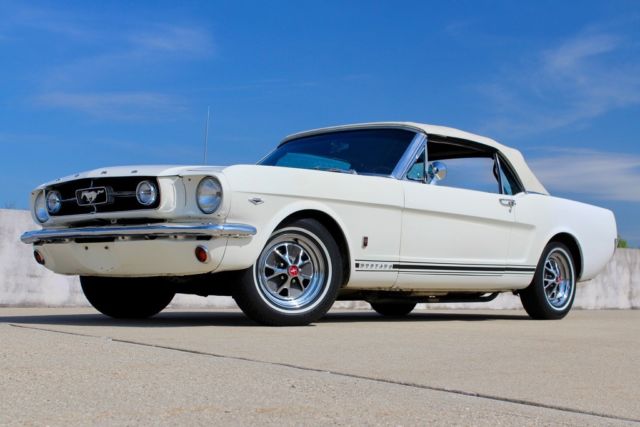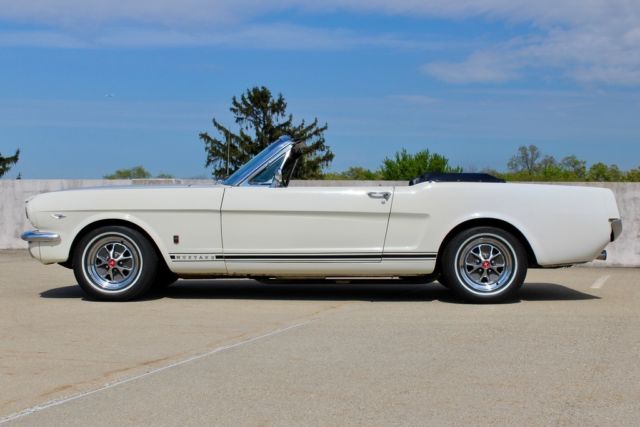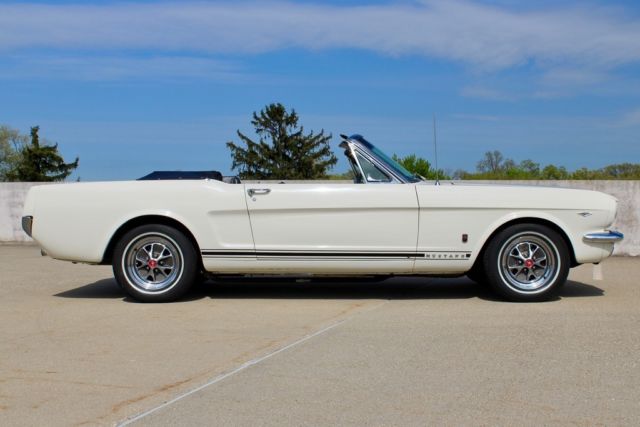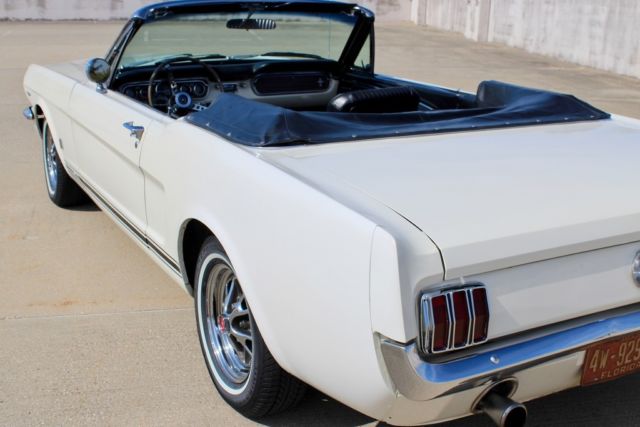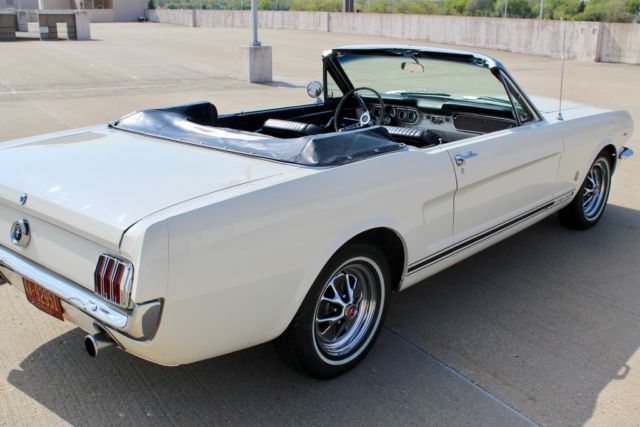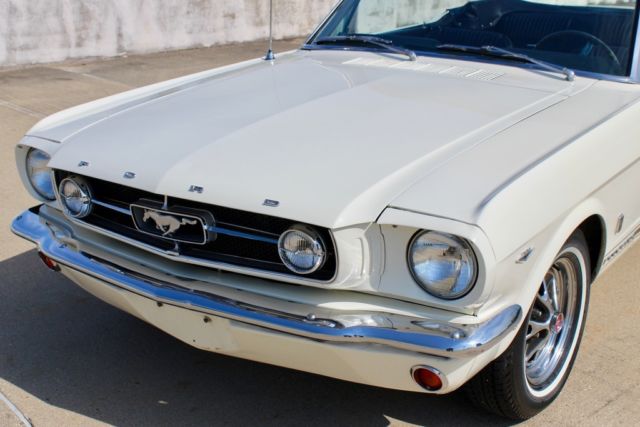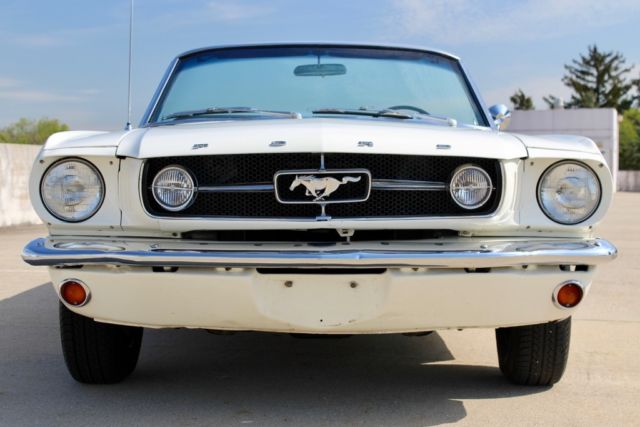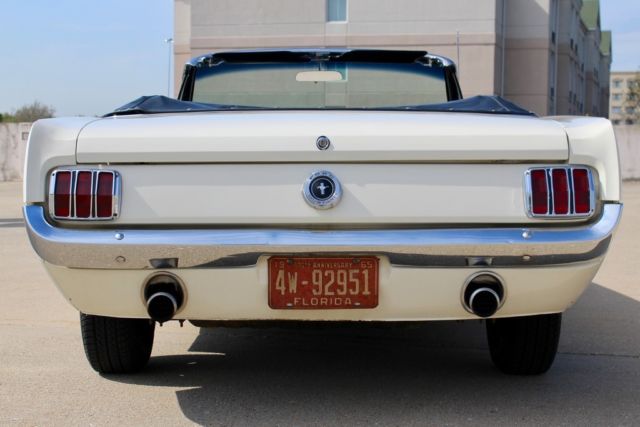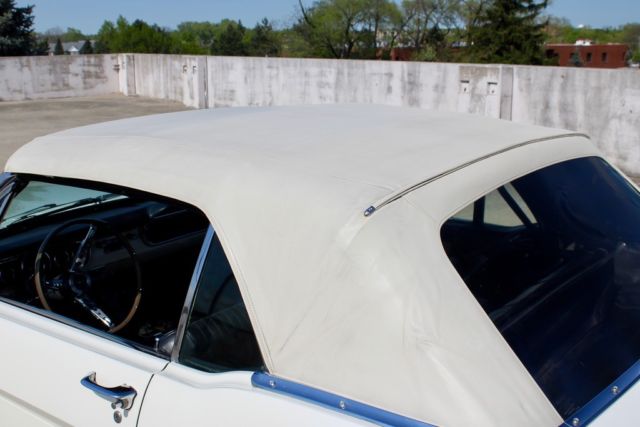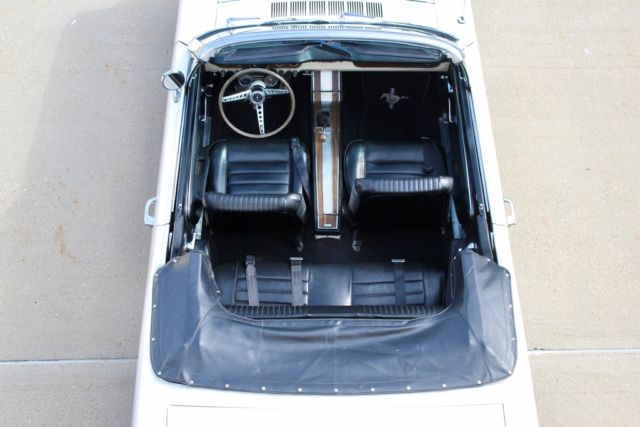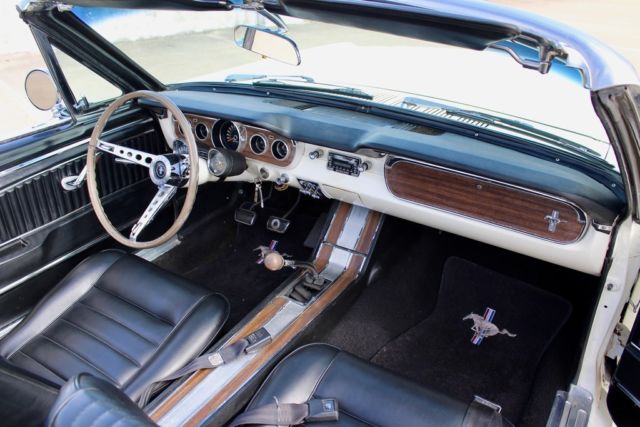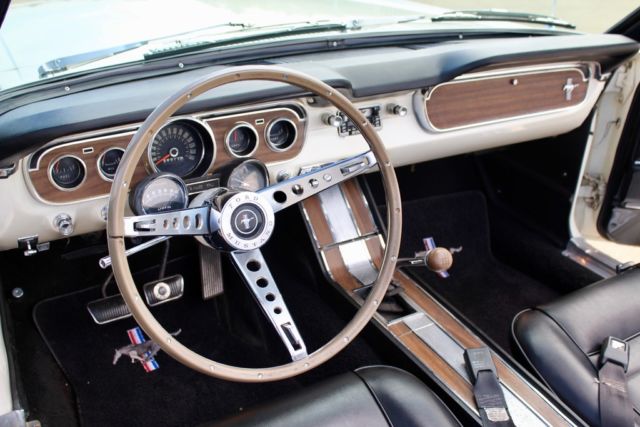1965 FORD MUSTANG GT, 4-SPEED WITH POWER TOP AND PONY INTERIOR
- Make: Ford
- Model: Mustang
- Year: 1965
- Mileage: 66,913
- Engine size: 289
- Number of cylinders: 8
- Fuel: Gasoline
- Drive type: RWD
- Options: Convertible
- Vehicle Title: Clear
- Interested?
1965 Ford Mustang Description
1965 Mustang GT Convertible, Original A Code Engine with 4-Speed Transmission and Power Top1965 Mustang GT Convertible, Original A Code Engine with 4-Speed Transmission and Power Top
This 1965 Mustang GT Convertible 4-Speed is an example of the second (and arguably one of the best) years of the all the early Mustang models and represents an era of automobiles that will never be seen again…
The condition of this car is original original and very well preserved.The car shows very few signs of age and shows 66,914 miles on the odometer, which I believe to be original.It has had either 3 or 4 owners from new.
A list of the options from the Ford factory include:
-Factory 4-Speed
-Factory A Code GT
-Power Top
-Original Color was Ivy Green
-Factory GT Gauge pack
-Pony Interior
-Chrome Steel wheels
-Light bar in front
-Dual rear exhaust
-A-Code engine option
Traction bars have also been installed by a previous owner for added stability.
BODY:
This Mustang GT was originally finished in Ivy Green, and was repainted Wimbleton White sometime in the late 1990’s.All of the body panels are ripple and dent free.
The finish is in nice overall condition and retains a nice shine, obviously the result of the car being garage kept and well cared for all of its life.
The glass and seals are in very nice condition and there are no leaks evident.
INTERIOR:
The interior is trimmed in the original black vinyl.The seating areas are in nice original condition, as are the door panels, dashboard, and console.The carpet is also in original condition, and has not been damaged by any effects of sun, spills or rodent damage.
All of the accessories are in working order.The dashboard includes a speedometer and tachometer as well as a radio, fuel gauge, ammeter, and oil pressure and water temperature gauges.
The windows are in good working condition. The door locks also work as well.The trunk area appears in nice original and preserved condition, the trunk mat is in very nice condition, and the spare tire, wheel, and trunk accessories are all present and in place.
UNDERCARRIAGE:
The underside of the car is in line with a 66,913 mile car and is well preserved, with few signs of age. As shown in the photos, the inner rocker, where it meets the floor pan, in an area approximately 3” x 4” x 6”, shows some rust on the outer pan only. The rest of the undercarriage is very solid, having spent the majority of its life in Florida.
ENGINE AND TRANSMISSION:
All of the mechanical aspects of the car have been inspected and repaired, if necessary.The motor is original to the car, with all numbers and codes matching, and the transmission is the optional 4-speed manual.
All of the engine, transmission, and differential fluids have been changed, all belts have been replaced, the cooling system flushed out, and a new battery installed.The fuel system has also been completely cleaned and updated, and there are no issues with starting and running the vehicle.
The following mechanical work was also performed on the car when I acquired it: Front and rear brakes were replaced and the clutch adjusted.
ENGINE COMPARTMENT:
The engine bay is completely original, with all components in operational condition.Every detail of the engine compartment is well preserved.There is minor wear to certain painted surfaces that has occurred due to age, but overall, it is very presentable.
As you can see from the photos of the stamped number on the fender and door tag, the numbers are correct. I have also attached a photo of the tag found on the steering box, which indicates and proves the car is a true GT model.
TIRES AND WHEELS:
The tires are the correct size and style for the wheels, which are also original to the car. If the new owner does intend to drive the car, the tires have plenty of life on them.
The wheels are in good original condition and have the typical age related wear associated with them.
OVERALL DRIVING IMPRESSIONS:
This Mustang runs as any car inthis condition should!The 289 ci V-8 powerplant runs and accelerates smoothly and very quickly and the 4-speed manual transmission shifts as it should.
The car runs and drives with no trouble. As stated at the top of the description,the car has had all of the necessary service recently performed including oil change, tune up, installation of new battery and brakes, and gearbox and differential service, and needs absolutely nothing to drive, show, and enjoy.All of the mechanical aspects of the car work as they should.
PLEASE NOTE:
This 1965 Mustang GT still retains all of its original components and is a nice well preserved driver/cruise night show car.This means the engine, transmission, rear end, etc. are original to the car. All of the numbers, markings, etc., are correct. It is an original and very special car, (being an original GT 4-speed power top car) that, as evidenced by the mileage, has been driven very sparingly during the last 57 years.
There is absolutely nothing that needs to be done to this car to drive it occasionally and enjoy it as a showpiece.
TERMS: 10% DEPOSIT WITHIN 48 HOURS OF AUCTION CLOSE.BALANCE OF AUCTION AMOUNT MUST BE PAID BY CASH IN PERSON, BANK TO BANK WIRE TRANSFER, OR CERTIFIED FUNDS (WITH VERIFICATION) ONLY WITHIN 7 DAYS OF AUCTION CLOSE.SORRY, NO C.O.D. AND NO PAYPAL.
The description of this vehicle is written to the best of my knowledge.However, I am by no means an expert on vintage Mustangs.Please don’t hesitate to ask for more photos and, if possible, come and look in person before the auction ends.ALL SALES ARE FINAL!If you have any questions, please contact me before the auction ends.
If you have any questions, please contact me.If you live close to Chicago, I encourage you to come and inspect the car in person!
In an effort to protect the eBay user information and to help ensure the authenticity of correspondence between sellers and bidders, eBay’s new listing format does NOT display any bidder information.Nevertheless, I STRONGLY encourage bidders to contact me directly to answer questions or to verify correspondence.Seller reserves the right to not accept bids or sell the vehicle to anyone with a zero or negative eBay feedback rating.
This vehicle is being sold as is, where is with no warranty, expressed, written or implied unless there is a warranty in effect from the factory.The seller shall not be responsible for the correct description, authenticity, genuineness, or defects herein, and makes no warranty in connection therewith.No allowance or set aside will be made on account of any incorrectness, imperfection, defect or damage.Any descriptions or representations are for identification purposes only and are not to be construed as a warranty of any type.It is the responsibility of the buyer to have thoroughly inspected the vehicle and to have satisfied himself or herself as to the condition and value and to bid based upon that judgment solely.The seller shall and will make every reasonable effort to disclose any known defects associated with this vehicle at the buyer's request PRIOR to the close of sale.Seller assumes no responsibility for any statements regardless of any oral statements about the vehicle.
Please remember that your bid constitutes a legally binding contract to purchase this item.If you require an inspection, have it done prior to bidding.I strongly encourage all bidders to inspect the vehicle personally or enlist the services of a professional inspector prior to placing a bid.After the sale, inspections are not recognized as a contingency to completing your obligation to your winning bid.If there are any questions regarding the above terms, please e-mail prior to bidding.
Please do not waste my time or yours bidding on an item you do not intend to pay for.If you bid on this vehicle and win, you are expected to pay and pick it up in a timely manner!
I welcome ALL international bidders and am happy to assist with making shipping arrangements.If you are an international buyer, I understand it can take some time to arrange shipping, so I do not mind keeping the vehicle for a longer period of time until pick up.Please contact me before the sale ends, if possible, to discuss the specifics.
Thanks for your interest!
For more on the Ford Mustang, please read on past the photos…
Here are some photos of theundercarriage of the car to give a good representation of thecurrent condition:
The Early Mustang Years...
In 1961, Lee Iacocca, vice president and general manager of Ford Division, had a vision. His vision was a car that would seat four people, have bucket seats, a floor mounted shifter, be no more than 180 inches long, weigh less than 2500 pounds, and sell for less than $2500.00. Out of this vision, the Ford Mustang was born.
After many months of meetings, discussions and market surveys, funding was finally approved for the Mustang in September of 1962. On March 9, 1964 the first Mustang rolled off of the assembly line. Only 18 months had elapsed since the Mustang had been approved for production. In order to keep production costs down, many of the Mustang's components were borrowed from the Falcon, including most of the drivetrain. With a multitude of different interior, exterior, and drivetrain options, the Mustang would be able to be ordered as plain, or as fancy, as economical, or as fast, as the buyer wanted. In general, the Mustang was designed for everyone and was advertised as "the car to be designed by you".
The Ford Mustang was heavily advertised during the latter part of it's development. On April 16, 1964, the day before it's release, Ford ran simultaneous commercials at 9:30pm on all three major television networks, ABC, NBC, and CBS. The following day, April 17, 1964, people "attacked" the Ford showrooms. Everyone was in a frenzy to be one of the first to own the Mustang. Ford sold over 22,000 Mustangs the first day. By the end of the year, Ford had sold 263,434. By the end of the Mustang's first anniversary, April 17, 1965, Ford had sold 418,812 Mustangs. The Mustang had made a name for itself, and it was here to stay!!!
The 1964½, as it was later called, was available in only two models: the coupe and convertible. Both models featured a lengthened hood and shortened rear deck, chrome wrap-around bumpers, chrome grille with a running horse, and full wheel covers. Both models were available with a 170 cid, 101 horsepower, 6 cylinder engine, a 260-2V, 164 horsepower V-8, a 289-4V, 210 horsepower V-8 and, starting in June, a fire breathing, 4 barrel, solid lifter, 271 horsepower, 289 cid V-8 engine.
The buyer had a choice of a 3 speed, 4 speed, or automatic transmission, and a variety of rear end gear ratios. The interior featured "wall-to-wall" carpeting, front bucket seats or an optional front bench seat, rear bench seat, a sports car style steering wheel, floor mounted shifter, and full headliner. There were a total of 121,538 Ford Mustangs produced during the 1964½ model run.
1965 brought few changes for the Mustang. The biggest change was the availability of a new fastback model, which was to become the basis for Carroll Shelby's GT350.The 120 horsepower, 200 cid 6-cylinder engine replaced the 170 cid 6-cylinder, the 289-2V, 200 horsepower V-8 replaced the 260-2V, the 289-4V was upgraded to 225 horsepower, and the 289-4V hi-po remained unchanged.
Other changes for the 1965 Mustang included: an alternator instead of a generator, relocation of the oil filler, integral power steering pump and resevoir (most 1964½'s had a remote mounted resevoir), a wire retaining ring was added to the gas cap, the horns were smaller and relocated, and the interior carpet was continued up the sides of the rocker panel and under the sill plate. A new interior option was added, the interior decor group (known as the pony interior), which featured special seat covers with running horses across the seat back, special interior door panes with integral arm rests and pistol grip door handles, five-gauge instrument panel, woodgrain steering wheel, and woodgrain appliques on the instrument cluster, glovebox, and optionally on the center console.
Another Mustang option introduced in April of 1965 was the GT equipment group. Available only with one of the two four barrel engines, the GT group included five-dial instrumentation, disc brakes, larger sway bars, quicker steering ratio, dual exhaust which exited through the rear valance panel, grill mounted foglights, and special lower body side stripes. A total of 559,451 Mustangs were produced for the 1965 model year.
A Short History You Probably Already Know…
Thefirst-generation Ford Mustangwas manufactured by Fordfrom March 1964 until 1973. The introduction of the Mustang created a new class of automobile known as the pony car. The Mustang’s styling, with its long hood and short deck, proved wildly popular and inspired a host of competition.
It was initially introduced as a hardtop and convertible with the fastback version put on sale in August 1964. At the time of its introduction, the Mustang, sharing its underpinnings with the Falcon, was slotted into a compact carsegment.
With each revision, the Mustang saw an increase in overall dimensions and in engine power. The 1971 model saw a drastic redesign to its predecessors. After an initial surge, sales were steadily declining, as Ford began working on a new generation Mustang. With the onset of the 1973 oil crisis, Ford was prepared, having already designed the smaller Mustang IIfor the 1974 model year. This new car had no common components with preceding models.
Conception and styling:
As Lee Iacocca'sassistant general manager and chief engineer, Donald N. Freywas the head engineer for the Mustang project — supervising the development of the Mustang in a record 18 months from September 1962 to March 1964.— while Iacocca himself championed the project as Ford Division general manager.
Drawing on inspiration from the mid-engined Ford Mustang Iconcept vehicle, Lee Iacoccaordered development of a new "small car"to vice-president of design at Ford, Eugene Bordinat. Bordinat tasked Ford's three design studios (Ford, Lincoln-Mercury, and Advanced Design) to create proposals for the new vehicle.
The design teams had been given five goalsfor the design of the Mustang: It would seat four, have bucket seats and a floor mounted shifter, weigh no more than 2,500 pounds (1,100kg) and be no more than 180 inches (4,572mm) in length, sell for less than $2,500, and have multiple power, comfort, and luxury options.
The Lincoln-Mercurydesign studio ultimately produced the winning design in the intramural contest, under Project Design Chief JoeOrosand his team of L. David Ash,Gale Halderman, and John Foster.
In a 2004 interview, Oros recalls the planning behind the design:
“I told the team that I wanted the car to appeal to women, but I wanted men to desire it, too. I wanted a Ferrari-like front end, the motif centered on the front – something heavy-looking like a Maseratti [sic], but, please, not a trident – and I wanted air intakes on the side to cool the rear brakes. I said it should be as sporty as possible and look like it was related to European design.”
Oros added:
“I then called a meeting with all the Ford studio designers. We talked about the sporty car for most of that afternoon, setting parameters for what it should look like -- and what it should not look like -- by making lists on a large pad, a technique I adapted from the management seminar. We taped the lists up all around the studio to keep ourselves on track. We also had photographs of all the previous sporty cars that had been done in the Corporate Advanced studio as a guide to themes or ideas that were tired or not acceptable to management.
Within a week we had hammered out a new design. We cut templates and fitted them to the clay model that had been started. We cut right into it, adding or deleting clay to accommodate our new theme, so it wasn't like starting all over. But we knew Lincoln-Mercury would have two models. And Advanced would have five, some they had previously shown and modified, plus a couple extras. But we would only have one model because Ford studio had a production schedule for a good many facelifts and other projects. We couldn't afford the manpower, but we made up for lost time by working around the clock so our model would be ready for the management review.”
L. David Ash is often credited with the actual styling of the Mustang. Ash, in a 1985 interview speaking of the origin of the Mustang design, when asked the degree of his contribution, said:
“I would say substantial. However, anyone that says they designed the car by themselves, is wrong. Iacocca didn't design it. He conceived it. He's called the father of it, and, in that respect, he was. I did not design it in total, nor did Oros. It was designed by a design group. You look at the photograph taken at the award banquet for the Industrial Designers’ Society where the Mustang received the medal; it’s got Damon Woods in it (the group that did the interior), and Charlie Phaneuf (who was with Damon), and it’s got myself and John Foster (who was with me), it’s got (John) Najjar in it.”
So nobody actually did the car, as such.Iacoccain his book flat out comes and says I did the car. It's right there in print, "It's Dave Ash's Mustang." Bordinat will tell you I did the car. This book tells you I did the car, but, in actual fact, I had a lot of help, and I don't think anyone ever does a car by himself, not in these times anyway.”
Gale Haldeman, in a 2002 interview with Collectible Automobile, spoke of the Mustang's evolution through the Lincoln-Mercury studio:
“David Ash had started a clay model of the car. He had this very boxy, very stiff-looking car. Joe came back from a management conference, saw it, and said, "No, no, no, we're not going to do that!" That's when he came to me....he said, "...we've just been given an assignment by [Gene] Bordinat to do a proposal on a small car that Lee [Iaccoca] wants to build. We've got to do one, and I want you to work on that project." I went home and sketched some cars, and I took about five or six sketches with me the next morning and put them up on the board.
We must have put 25 sketches on the board that morning, because Joe assigned three or four of us to do designs. Joe picked one of the sketches I did at home to be clay modeled....so we actually started over on [Dave Ash's] clay model with the theme from one of my designs, which had scoops on the sides and the hop-up quarter lines.”
To decrease developmental costs, the Mustang used chassis, suspension,and drivetrain components derived from the Ford Falcon and Fairlane. It used a unitized platform-type frame from the 1964 Falcon, and welded box-section side rails, including welded crossmembers. Although hardtop Mustangs accounted for the highest sales, durability problems with the new frame led to the engineering of a convertible first, which ensured adequate stiffness.
Overall length of the Mustang and Falcon was identical, although the Mustang's wheelbasewas slightly shorter. With an overall width of 68.2in (1,732mm), it was 2.4in (61mm) narrower, yet the wheel track was nearly identical. Shipping weight, approximately 2,570lb (1,166kg) with the straightsix-cylinderengine, was also similar to the Falcon. A fully equipped V8model weighed approximately 3,000lb (1,361kg).
Although most of the mechanical parts were from the Falcon, the Mustang's body was completely different; sporting a shorter wheelbase, wider track, lower seating position and lower overall height. An industry first, the "torque box" was an innovative structural system that greatly stiffened the Mustang's construction and helped contribute to better handling.
Gale Haldeman spoke of the engineering and design of the car in his interview, stating:
“No one knew the Mustang was going to be as popular as it was, but it created a huge stir in the company. Everybody just loved it, even the engineers, though we must have bent 75 in-house engineering and manufacturing rules. The Mustang had the first floating bumpers. The whole front end was a die-casting with a floating hood.”
“There were so many things the engineers said we shouldn't be doing, but they didn't want to change them either. There was so much enthusiasm right from the beginning. Even the drivers at the test track loved it. We would go there for meetings, and the crowds of people around it were huge. That was totally unusual, so we suspected the Mustang was going to be a hit.”
The idea for a fastback originated with Joe Oros as well, and was designed in Charlie Phaneuf's studio.Haldeman recalls as follows:
“We did it in secret. No one, including [Hal] Sperlich or Iacocca, saw it until it was finished. We cast it in fiberglass, painted it bright red, and then showed it to Iacocca. He said, "We've got to do it!"
An additional 4-door model was designed by Dave Ash as a clay model, but was not considered.
1964–1966 Model Years...
Since it was introduced four months before the normal start of the 1965 production year and manufactured alongside 1964 Ford Falcons and 1964 Mercury Comets,the earliest Mustangs are widely referred to as the 1964½ model. Nevertheless, all "1964½" cars were given 1965 U.S. standard VINsat the time of production, and - with limited exception to the earliest of promotional materials - were marketed by Ford as 1965 models. The low-end model hardtop used a "U-code" 170cuin (2.8L) straight-6 engine borrowed from the Falcon, as well as a three-speed manual transmission and retailed for US$2,368. Standard equipment for the early 1965 Mustangs included black front seat belts, a glove box light, and a padded dash board. Production began in March 1964 and official introduction following on April 17 at the 1964 World's Fair.
Several changes to the Mustang occurred at the start of the "normal" 1965 model year in August 1964, about four months after its introduction. These cars are known as "late 65's". The engine lineup was changed, with a 200cuin (3.3L) "T-code" engine that produced 120hp (89kW; 122PS). Production of the "F-code" 260cuin (4.3L) engine ceased when the 1964 model year ended. It was replaced with a new 200hp (150kW) "C-code" 289cuin (4.7L) engine with a two-barrel carburetoras the base V8. An "A-code" 225hp (168kW; 228PS) four-barrel carbureted version was next in line, followed by the unchanged "Hi-Po" "K-code" 271hp (202kW; 275PS) 289. The DC electrical generatorwas replaced by a new AC alternatoron all Fords (a way to distinguish a 1964 from a 1965 is to see if the alternator light on the dash says "GEN" or "ALT").
The Mustang GT version was introduced as the "GT Equipment Package" and included a V8 engine(most often the 225hp (168kW; 228PS) 289), grille-mounted fog lamps, rocker panel stripes, and disc brakes. In the interior the GT option added a different instrument panel that included a speedometer, fuel gauge, temp. gauge, oil pressure gauge and ammeter in five round dials (the gauges were not marked with numbers, however.) A four-barrel carbureted engine was now available with any body style.
Additionally, reverse lights were an option added to the car from August 1964 production. The Mustang was originally available as either a hardtop or convertible, but during the car's early design phases a fastback model was strongly considered. In 1965, the Shelby Mustangwas born, it was available only in newly introduced fastbackbody version with its swept-back rear glass and distinctive ventilation louvers.
The standard interior features of the 1965 Mustang included adjustable driver and passenger bucket seats, an AM radio, and a floor mounted shifter in a variety of color options. Ford added additional interior options during the 1965 model year. The Interior Decor Group was popularly known as "Pony Interior" due to the addition of embossed running ponies on the seat fronts, and also included integral armrests, woodgrain appliqué accents, and a round gauge cluster that would replace the standard Falconinstrumentation. Also available were sun visors, a (mechanical) remote-operated mirror, a floor console, and a bench seat. Ford later offered an under-dash air-conditioning unit, and discontinued the vinyl with cloth insert seat option, offered only in early 1965 models.
One option designed strictly for fun was the Rally-Pac. Introduced in 1963 after Ford's success at that year's Monte Carlo Rallyand available on other Ford and Mercury compacts and intermediates, the Rally-Pac was a combination clock and tachometer mounted to the steering column. It was available as a factory ordered item for US$69.30. Installed by a dealer, the Rally-Pac cost US$75.95. A 14" rim option was available for Rally-pac and GT350R vehicles widening front and rear track to 57.5". Reproductions are presently available from any number of Mustang restoration parts sources.A compass, rear seat belts, A/C, and back-up lights were also optional.
Nationwide survey of owners by Popular Mechanics included many complaints about leg room. Fuel economy was very good for the period, with a published test by Popular Mechanics rating the small 260 cubic inch V8 with automatic transmission at 20.93 mpg at 60mph.
The 1966 Mustang debuted with moderate trim changes including a new grille, side ornamentation, wheel covers and gas cap. Ford's new C-4 "cruise-o-matic" three-speed auto transmission became available for the 225hp V8. The 289 "HiPo" K-code engine was also offered with a c4 transmission, but it had stronger internals and can be identified by the outer casing of the servo which is marked with a 'C'. The long duration solid-lifter camshaft that allowed the high revving 289 to make the horsepower it was known for, was not friendly for a low stall speed automatic torque converter.
The "HiPo" could be spotted very easily by the 1-inch-thick (25mm) vibration damper, (as compared to 1/2inch on the 225-hp version) and the absence of a vacuum advance unit on the dual point distributor. With the valve covers off, there is a large letter "K" stamped between the valve springs, along with screw in studs (vs. a pressed in stud for other 289s) for the adjustable rocker arms. A large number of new paint and interior color options, an AM/Eight-tracksound system, and one of the first AM/FM monoautomobile radios were also offered. It also removed the Falcon instrument cluster; the previously optional features, including the round gauges and padded sun visors, became standard equipment. The Mustang would be the best-selling convertible in 1966, with 72,119 sold, beating the number two Impalaby almost 2:1.
The 1965 and 1966 Mustangs are differentiated by variations in the exterior, despite similar design. These variations include the emblem on the quarter-panels behind the doors. From August 1964 production, the emblem was a single vertical piece of chrome, while for 1966 models the emblem was smaller in height and had three horizontal bars extending from the design, resembling an "E". The front intake grilles and ornaments were also different. The 1965 front grille used a "honeycomb" pattern, while the 1966 version was a "slotted" style.
While both model years used the "Horse and Corral" emblem on the grille, the 1965 had four bars extending from each side of the corral, while on the 1966, these bars were removed. The 1966 model year saw introduction of 'High Country Special' limited edition, 333 of them were sold in Colorado, Wyoming, and Nebraska.
When Ford wanted to introduce the Mustang in Germany, they discovered that the Kruppcompany had already registered the name for a truck. The German company offered to sell the rights for US$10,000. Ford refused and removed Mustang badges from exported units, instead naming the cars as T-5 (a pre-production Mustang project name) for the German market until 1979 when Krupp copyrights expired.
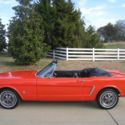 1965 Ford Mustang Convertible 289 V8 4-speed w/ Pony Interior
1965 Ford Mustang Convertible 289 V8 4-speed w/ Pony Interior
Mileage: 48,234
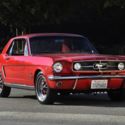 1965 Ford Mustang Coupe, 289 3 Speed, GT, A/C, PS, PB, Pony Interior, Console
1965 Ford Mustang Coupe, 289 3 Speed, GT, A/C, PS, PB, Pony Interior, Console
Mileage: 124,553
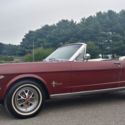 1965 Ford Mustang Convertible 4 Speed Pony Interior Pwr Top Pwr Steering
1965 Ford Mustang Convertible 4 Speed Pony Interior Pwr Top Pwr Steering
Mileage: 138,347
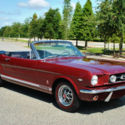 1965 Ford Mustang GT Convertible 'A' Code 289 V8 4 Barrel 4-Speed Pony Interior!
1965 Ford Mustang GT Convertible 'A' Code 289 V8 4 Barrel 4-Speed Pony Interior!
Mileage: 76,983
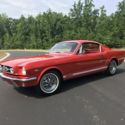 1965 Ford Mustang GT Fastback 289 A Code 4-Speed Red Pony interior Rally Pac
1965 Ford Mustang GT Fastback 289 A Code 4-Speed Red Pony interior Rally Pac
Mileage: 79,474
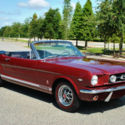 1965 Ford Mustang GT Convertible 'A' Code 289 V8 4 Barrel 4-Speed Pony Interior!
1965 Ford Mustang GT Convertible 'A' Code 289 V8 4 Barrel 4-Speed Pony Interior!
Mileage: 76,983
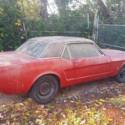 1965 FORD MUSTANG COUPE A CODE GT PONY INTERIOR 289 FACTORY 4 SPEED
1965 FORD MUSTANG COUPE A CODE GT PONY INTERIOR 289 FACTORY 4 SPEED
Mileage: 85,000
 1965 Ford Mustang GT Convertible 'A' Code 289 V8 4 Barrel 4-Speed Pony Interior!
1965 Ford Mustang GT Convertible 'A' Code 289 V8 4 Barrel 4-Speed Pony Interior!
Mileage: 76,983
 1965 Ford Mustang GT Convertible 'A' Code 289 V8 4 Barrel 4-Speed Pony Interior!
1965 Ford Mustang GT Convertible 'A' Code 289 V8 4 Barrel 4-Speed Pony Interior!
Mileage: 76,983
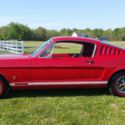 1965 Ford Mustang Fastback Restored A Code GT 4 Speed Pony Interior Beautiful
1965 Ford Mustang Fastback Restored A Code GT 4 Speed Pony Interior Beautiful
Mileage: 129,079
